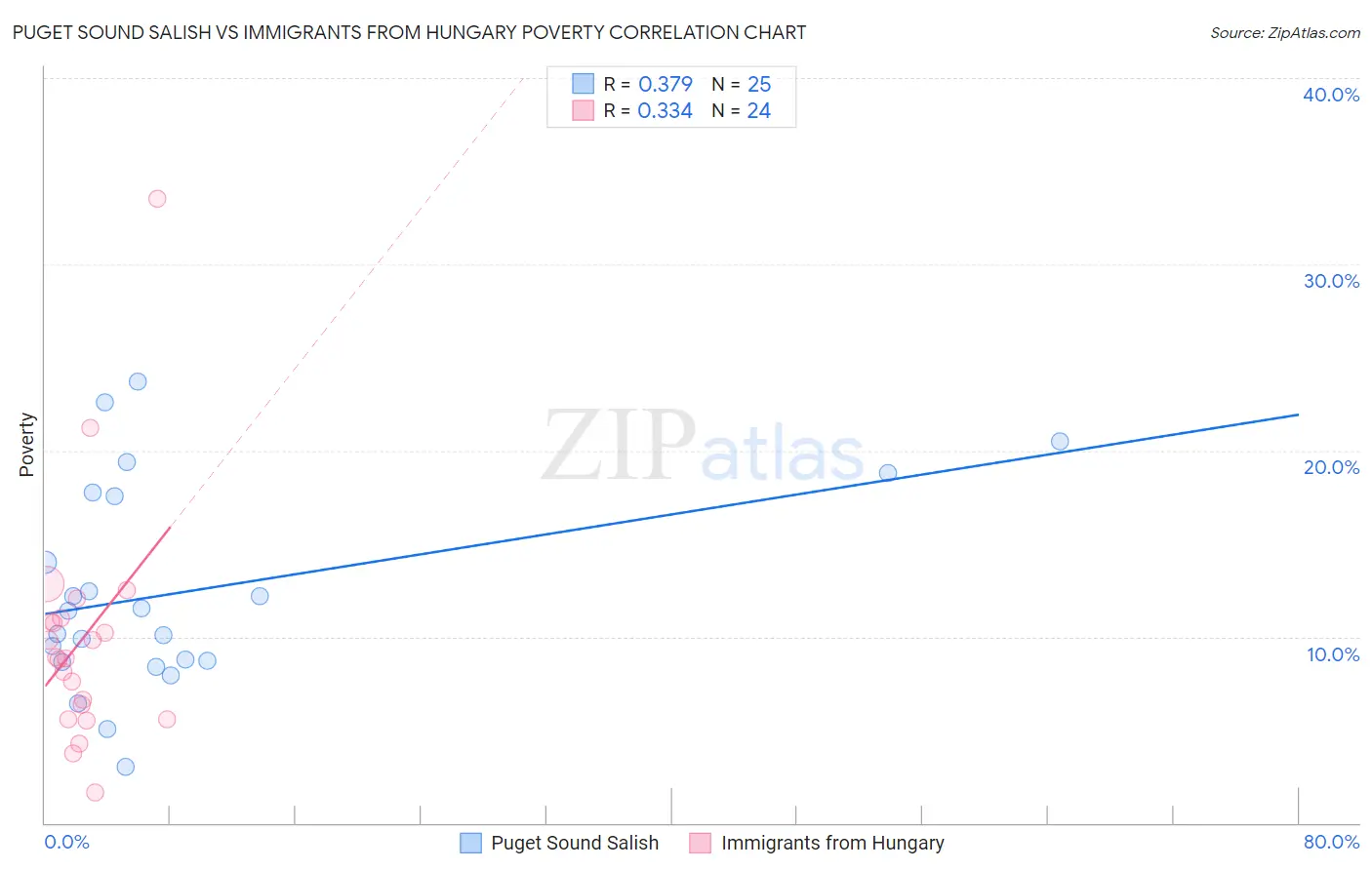Puget Sound Salish vs Immigrants from Hungary Poverty
COMPARE
Puget Sound Salish
Immigrants from Hungary
Poverty
Poverty Comparison
Puget Sound Salish
Immigrants from Hungary
11.7%
POVERTY
88.7/ 100
METRIC RATING
122nd/ 347
METRIC RANK
11.7%
POVERTY
88.6/ 100
METRIC RATING
123rd/ 347
METRIC RANK
Puget Sound Salish vs Immigrants from Hungary Poverty Correlation Chart
The statistical analysis conducted on geographies consisting of 46,150,573 people shows a mild positive correlation between the proportion of Puget Sound Salish and poverty level in the United States with a correlation coefficient (R) of 0.379 and weighted average of 11.7%. Similarly, the statistical analysis conducted on geographies consisting of 195,671,774 people shows a mild positive correlation between the proportion of Immigrants from Hungary and poverty level in the United States with a correlation coefficient (R) of 0.334 and weighted average of 11.7%, a difference of 0.020%.

Poverty Correlation Summary
| Measurement | Puget Sound Salish | Immigrants from Hungary |
| Minimum | 3.0% | 1.6% |
| Maximum | 23.7% | 33.5% |
| Range | 20.7% | 31.9% |
| Mean | 12.4% | 9.8% |
| Median | 11.4% | 8.9% |
| Interquartile 25% (IQ1) | 8.7% | 6.0% |
| Interquartile 75% (IQ3) | 17.7% | 10.9% |
| Interquartile Range (IQR) | 9.0% | 4.9% |
| Standard Deviation (Sample) | 5.5% | 6.4% |
| Standard Deviation (Population) | 5.4% | 6.3% |
Demographics Similar to Puget Sound Salish and Immigrants from Hungary by Poverty
In terms of poverty, the demographic groups most similar to Puget Sound Salish are New Zealander (11.7%, a difference of 0.0%), Immigrants from South Eastern Asia (11.7%, a difference of 0.060%), Tlingit-Haida (11.7%, a difference of 0.070%), Soviet Union (11.7%, a difference of 0.090%), and Argentinean (11.7%, a difference of 0.11%). Similarly, the demographic groups most similar to Immigrants from Hungary are New Zealander (11.7%, a difference of 0.020%), Soviet Union (11.7%, a difference of 0.070%), Immigrants from South Eastern Asia (11.7%, a difference of 0.080%), Tlingit-Haida (11.7%, a difference of 0.090%), and Immigrants from Brazil (11.7%, a difference of 0.11%).
| Demographics | Rating | Rank | Poverty |
| Immigrants | Southern Europe | 90.8 /100 | #112 | Exceptional 11.6% |
| Immigrants | Belarus | 90.8 /100 | #113 | Exceptional 11.6% |
| Immigrants | China | 90.7 /100 | #114 | Exceptional 11.6% |
| Albanians | 90.3 /100 | #115 | Exceptional 11.7% |
| Immigrants | Russia | 89.7 /100 | #116 | Excellent 11.7% |
| Sri Lankans | 89.4 /100 | #117 | Excellent 11.7% |
| Argentineans | 89.1 /100 | #118 | Excellent 11.7% |
| Tlingit-Haida | 89.0 /100 | #119 | Excellent 11.7% |
| Immigrants | South Eastern Asia | 88.9 /100 | #120 | Excellent 11.7% |
| New Zealanders | 88.7 /100 | #121 | Excellent 11.7% |
| Puget Sound Salish | 88.7 /100 | #122 | Excellent 11.7% |
| Immigrants | Hungary | 88.6 /100 | #123 | Excellent 11.7% |
| Soviet Union | 88.4 /100 | #124 | Excellent 11.7% |
| Immigrants | Brazil | 88.2 /100 | #125 | Excellent 11.7% |
| Immigrants | Norway | 88.0 /100 | #126 | Excellent 11.7% |
| Immigrants | Argentina | 88.0 /100 | #127 | Excellent 11.7% |
| Immigrants | Israel | 87.4 /100 | #128 | Excellent 11.7% |
| South Africans | 87.0 /100 | #129 | Excellent 11.7% |
| Immigrants | Ukraine | 86.6 /100 | #130 | Excellent 11.8% |
| French | 86.1 /100 | #131 | Excellent 11.8% |
| Peruvians | 85.6 /100 | #132 | Excellent 11.8% |